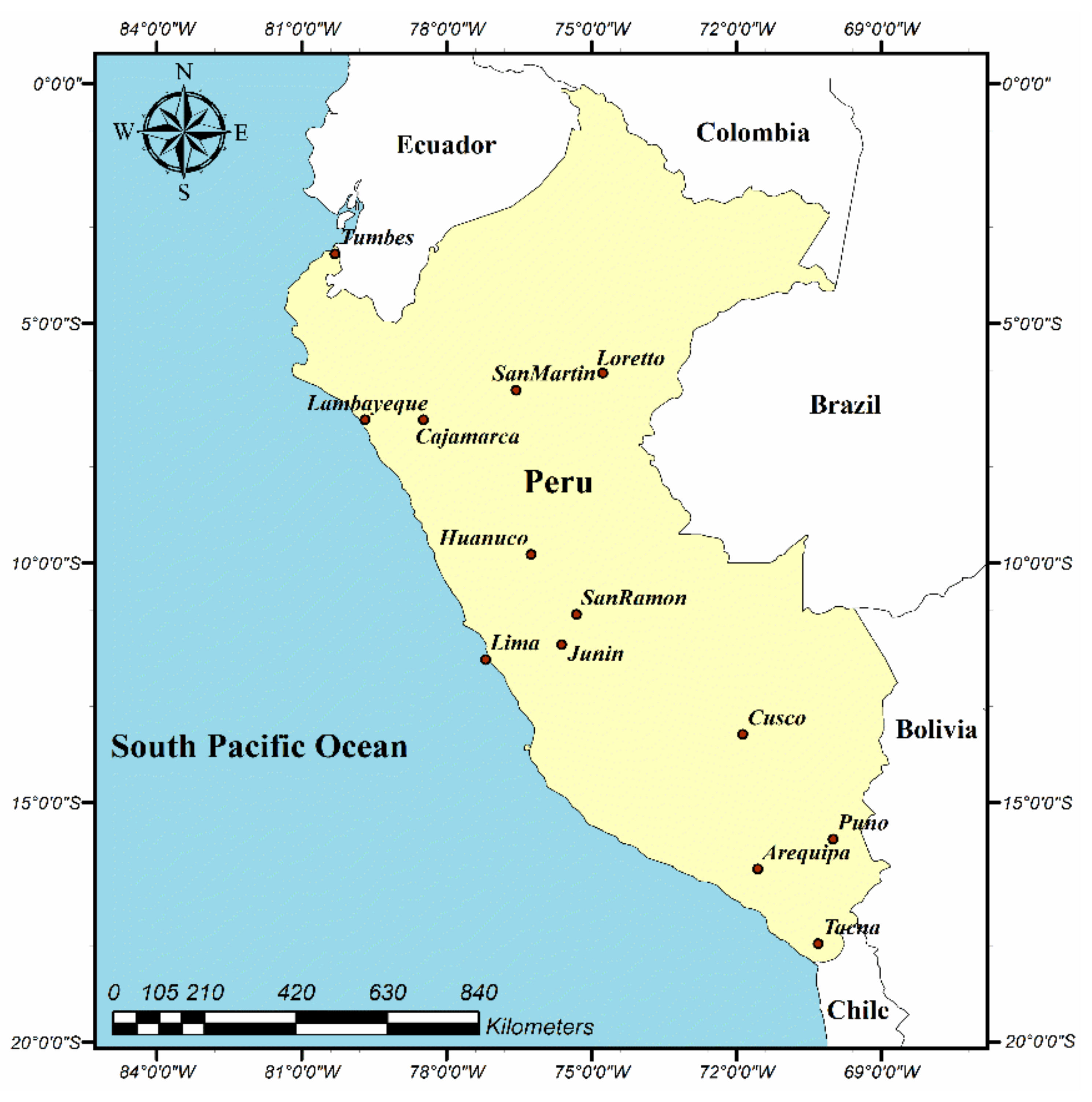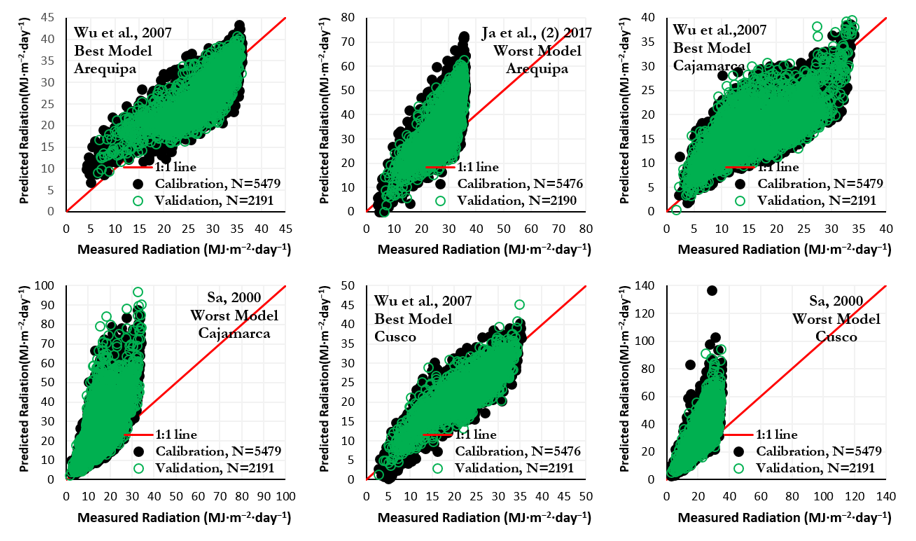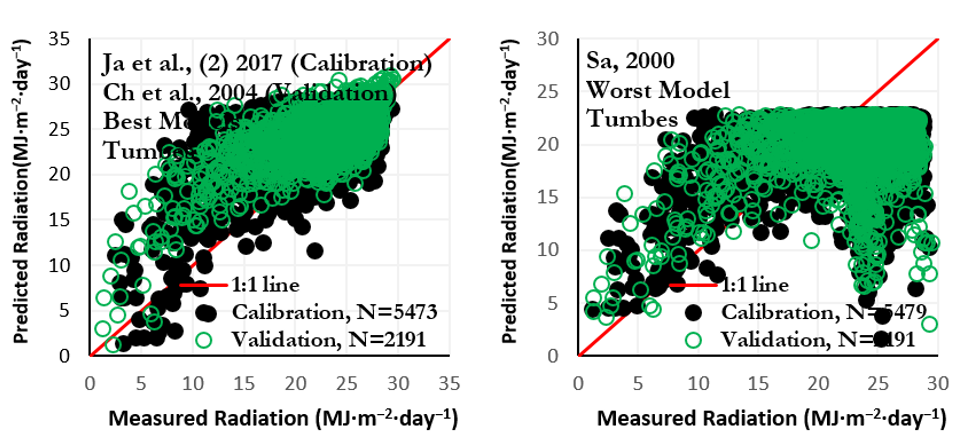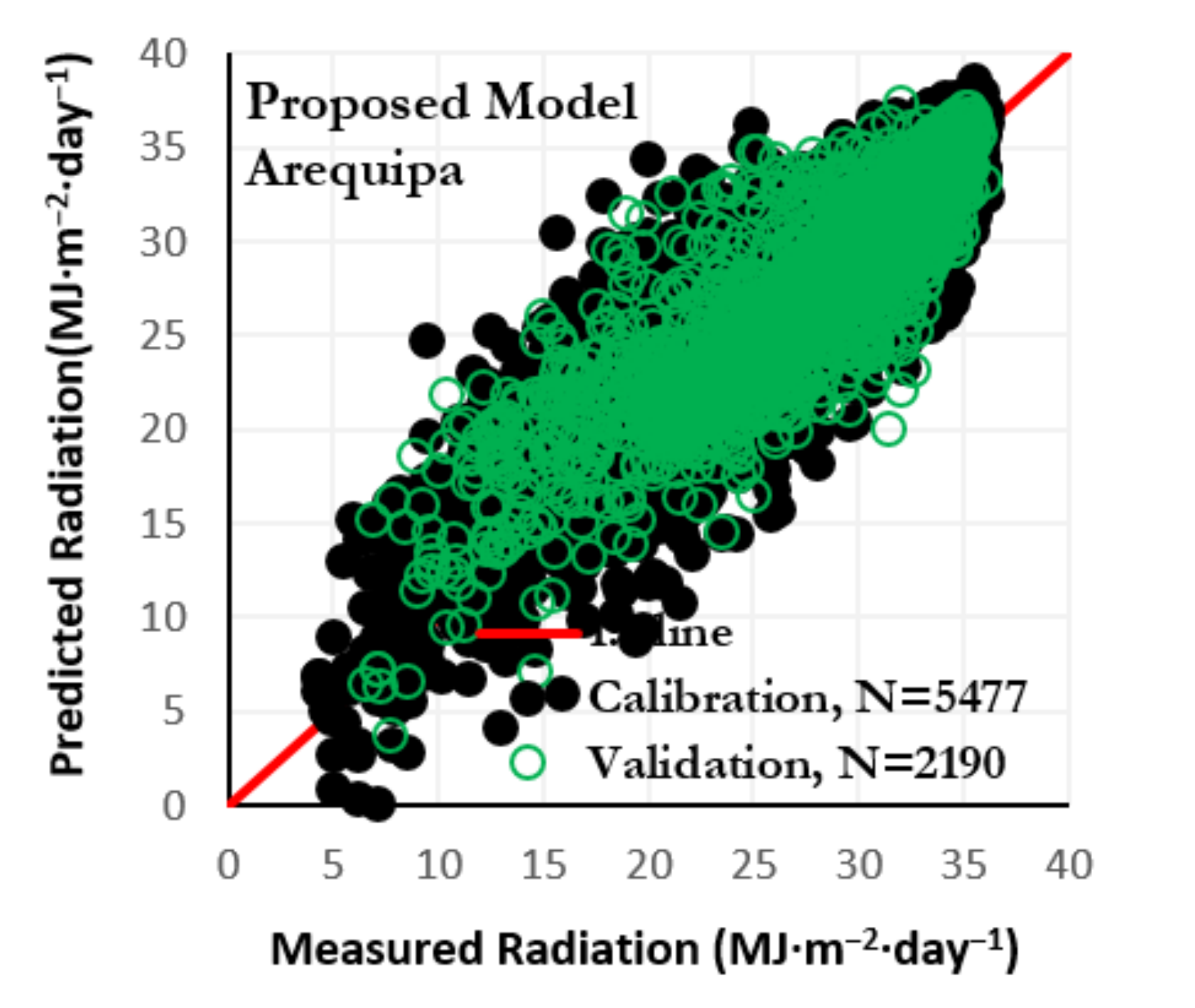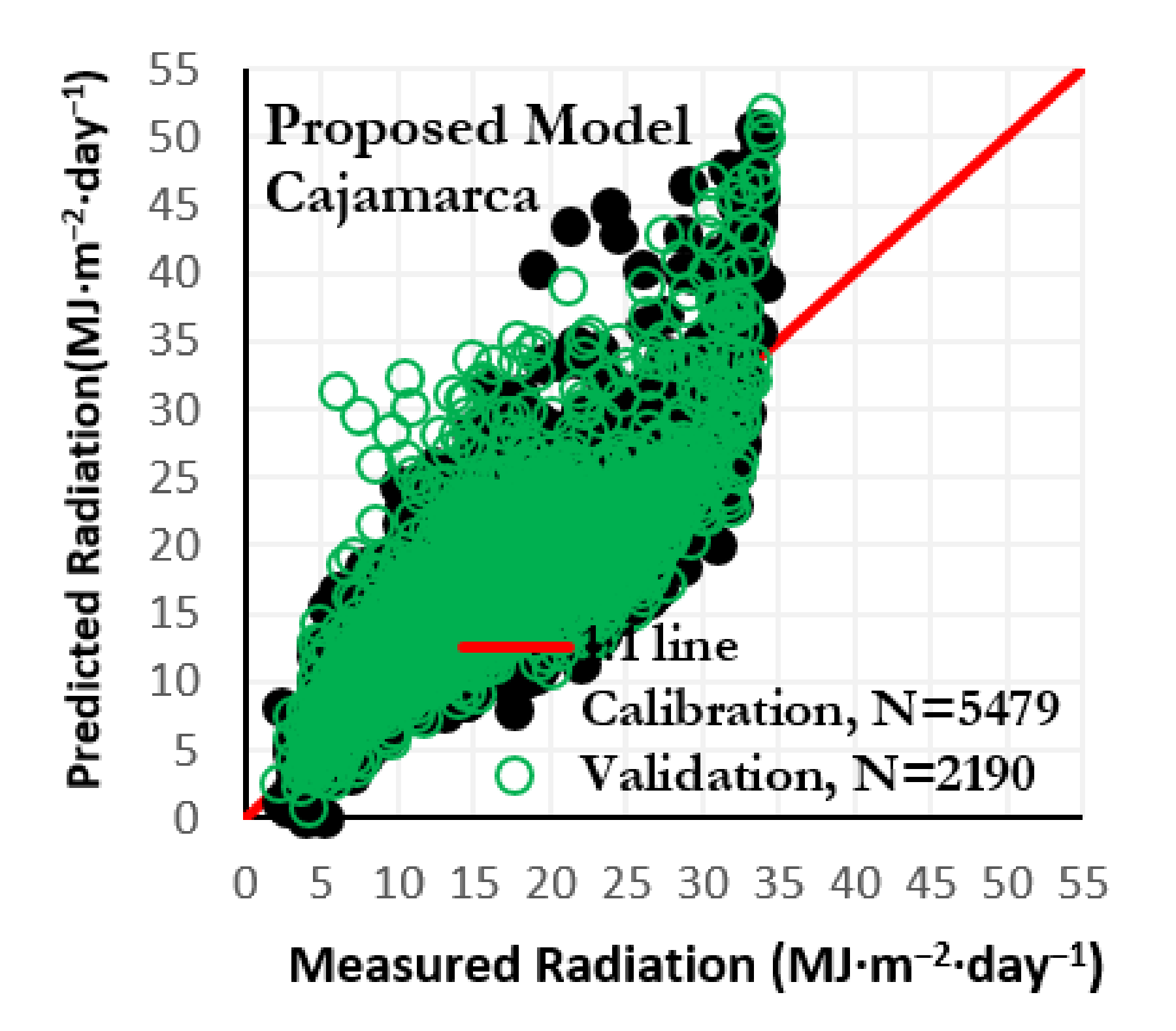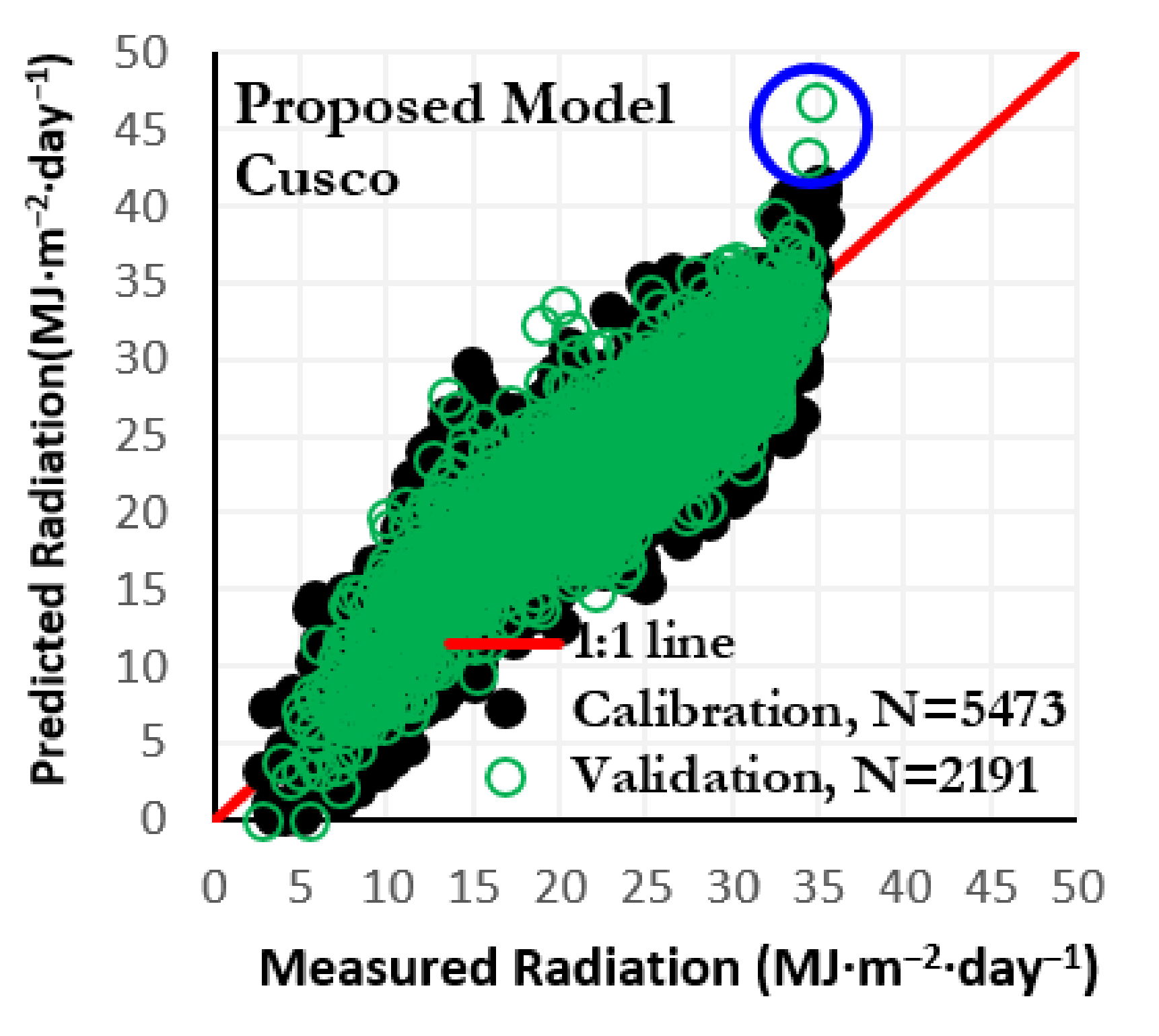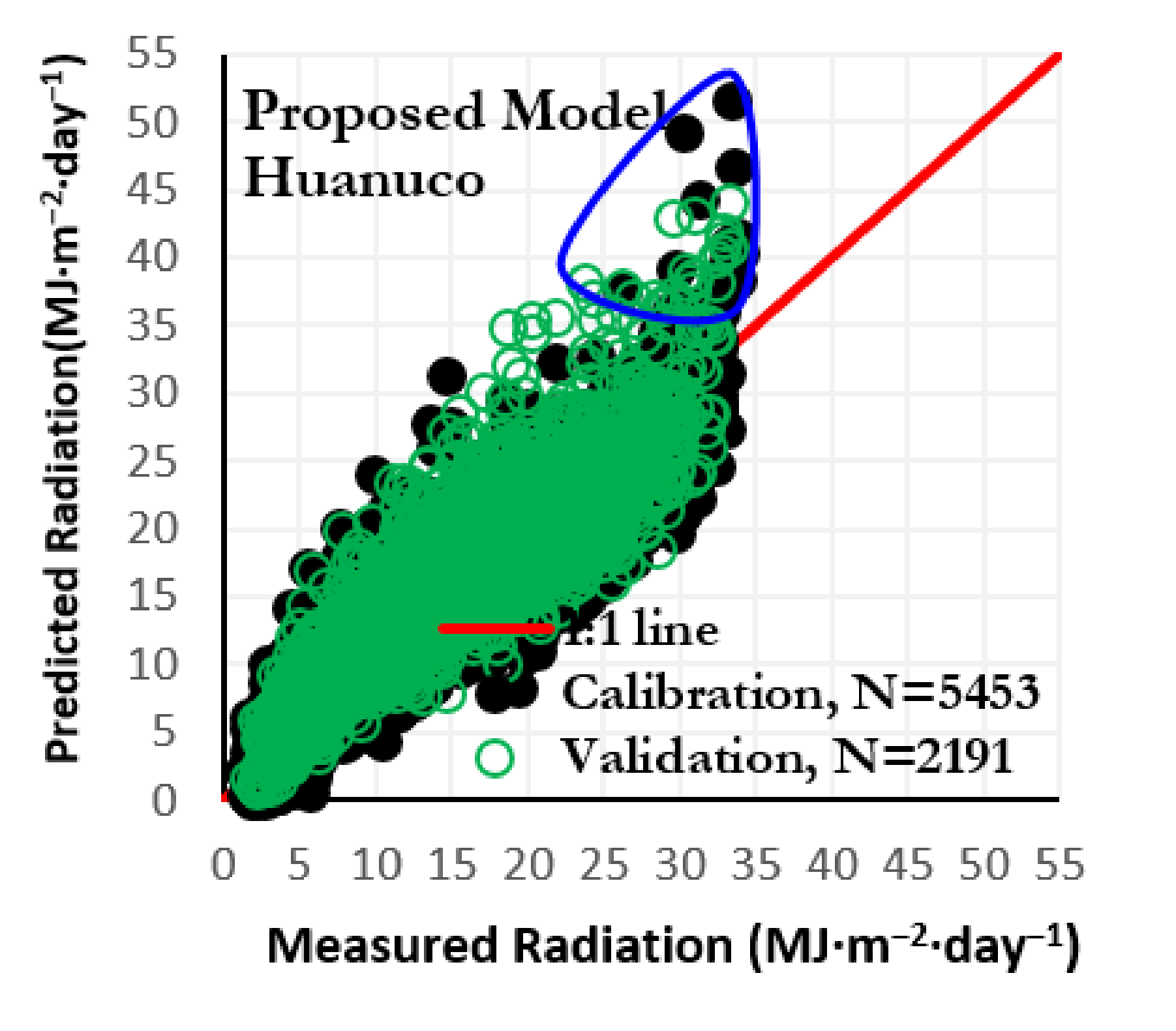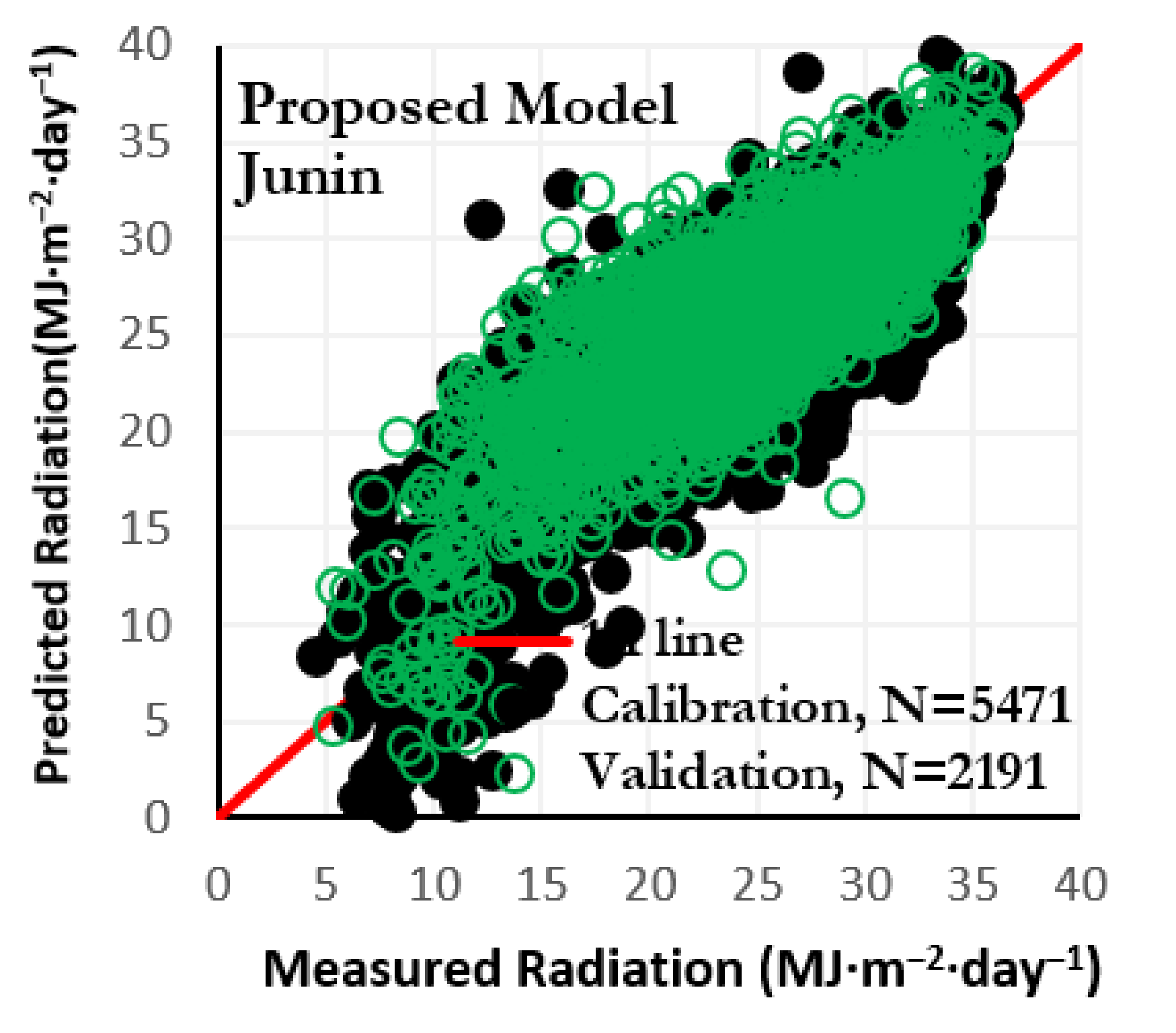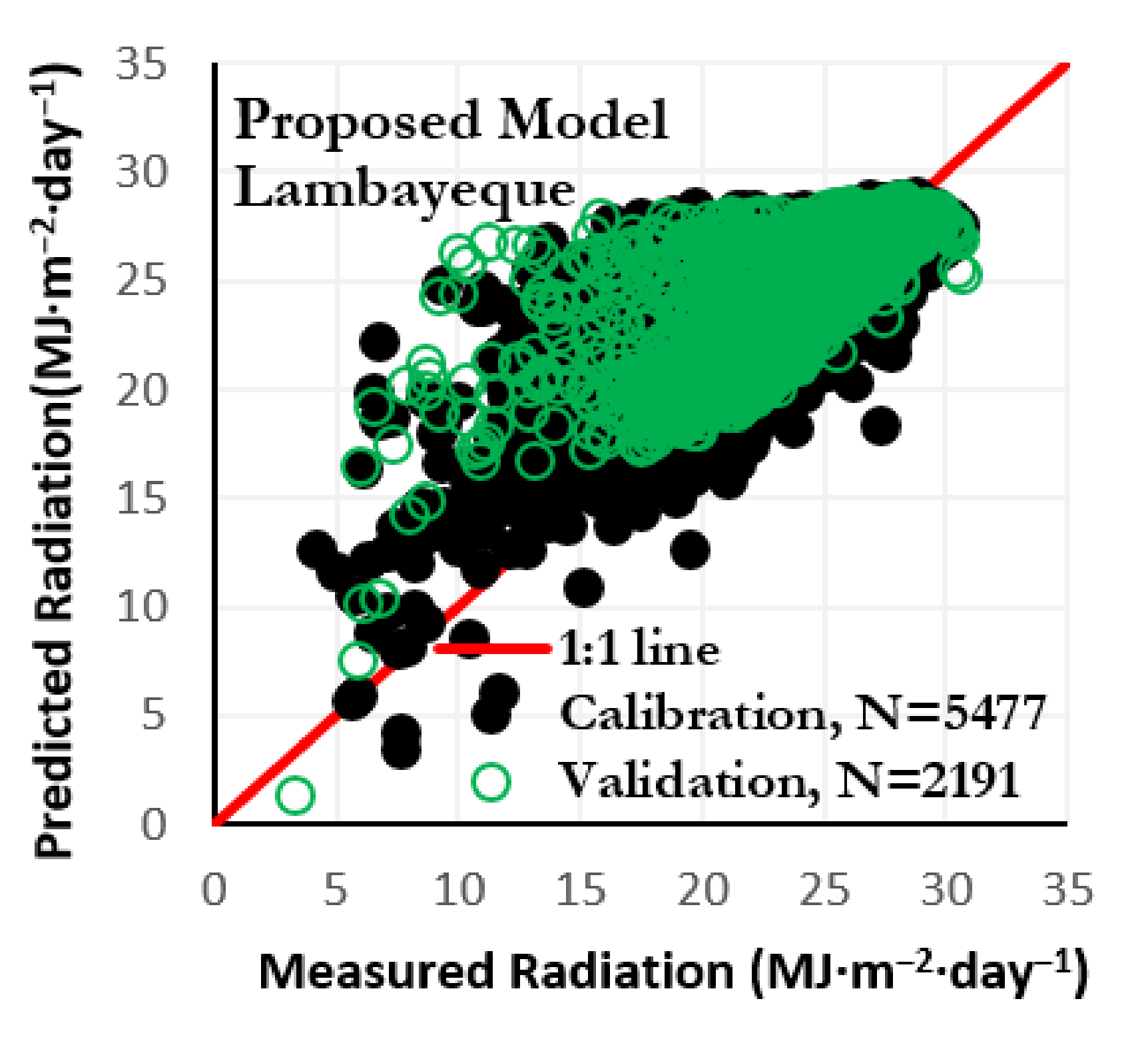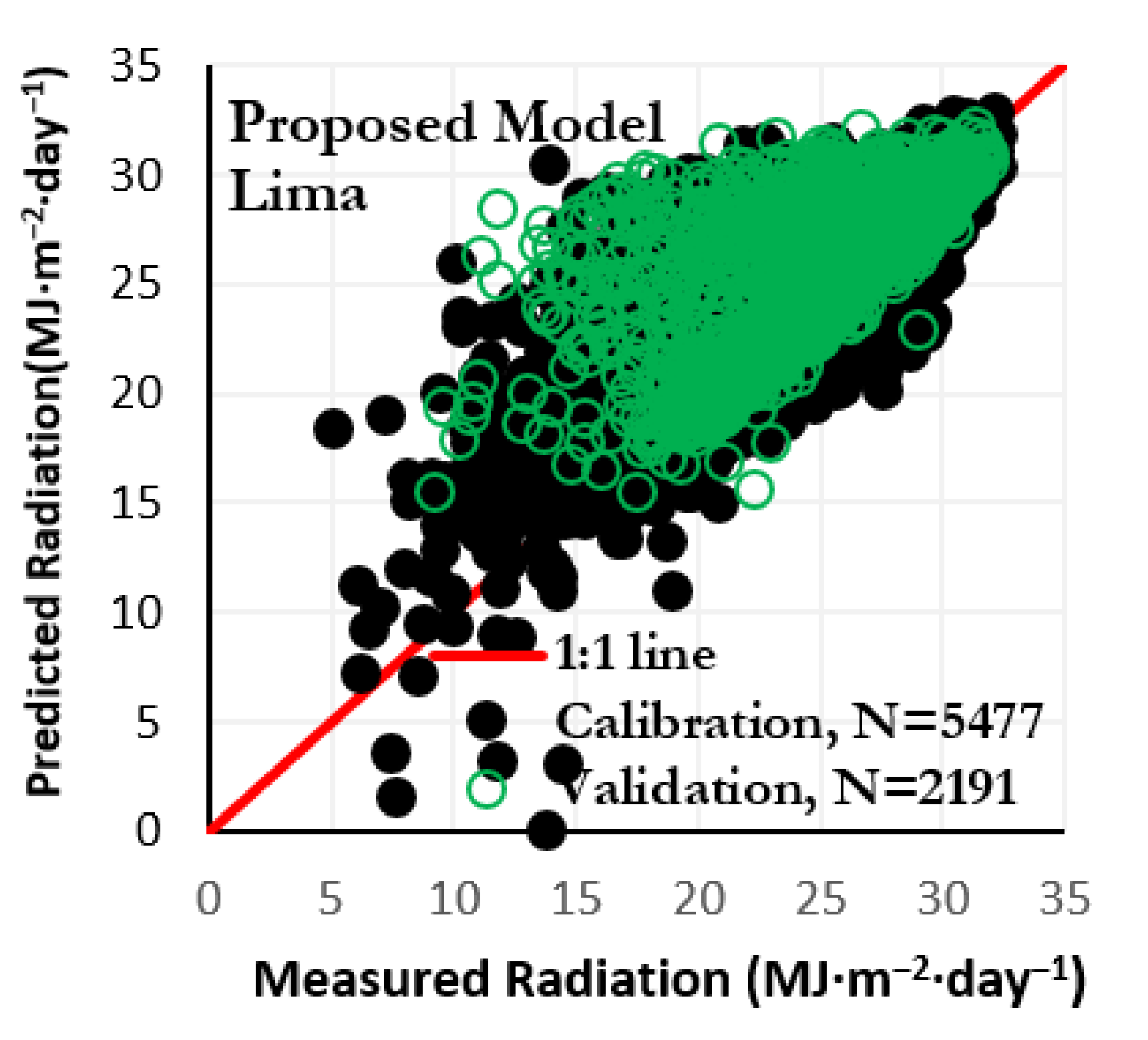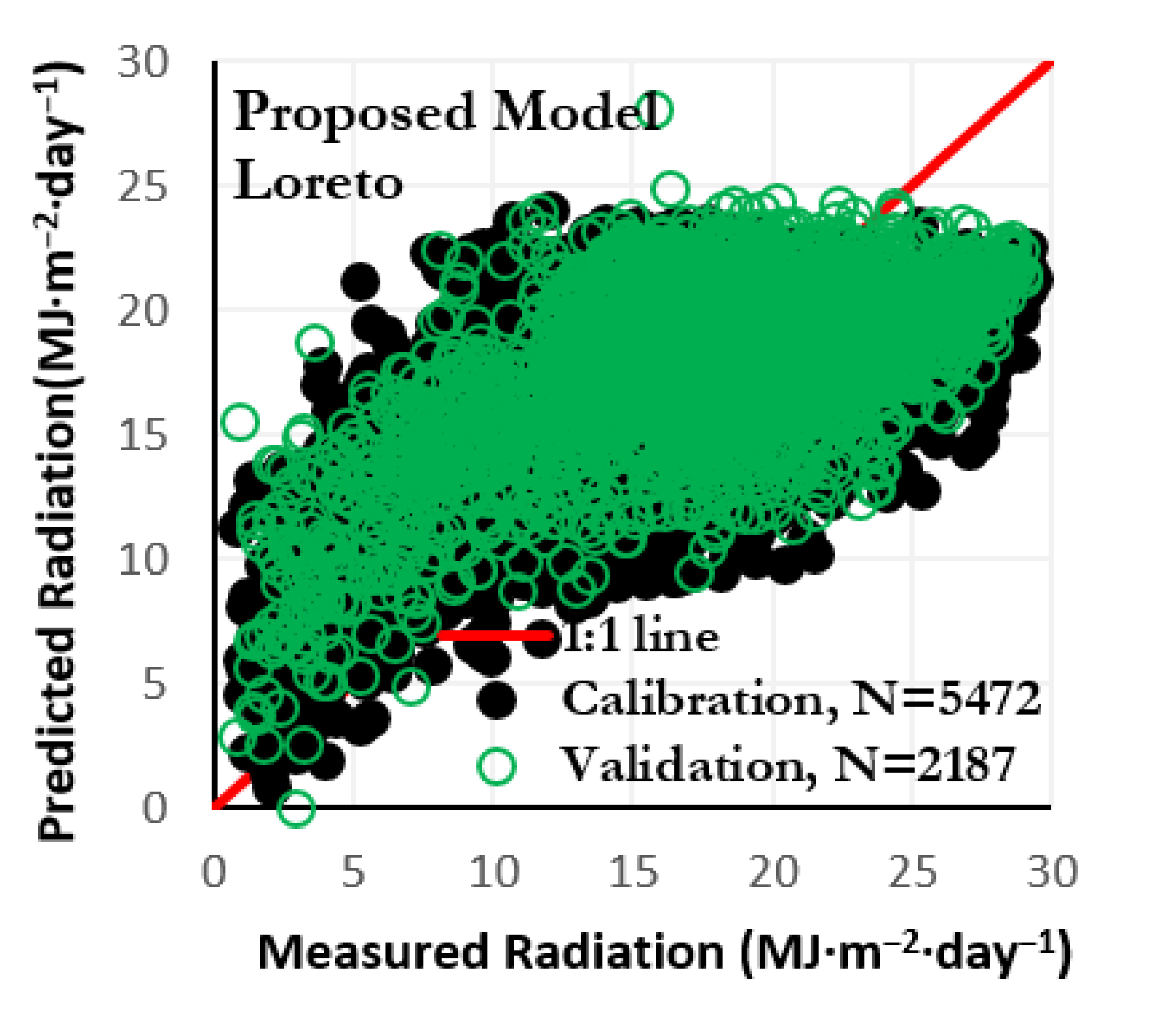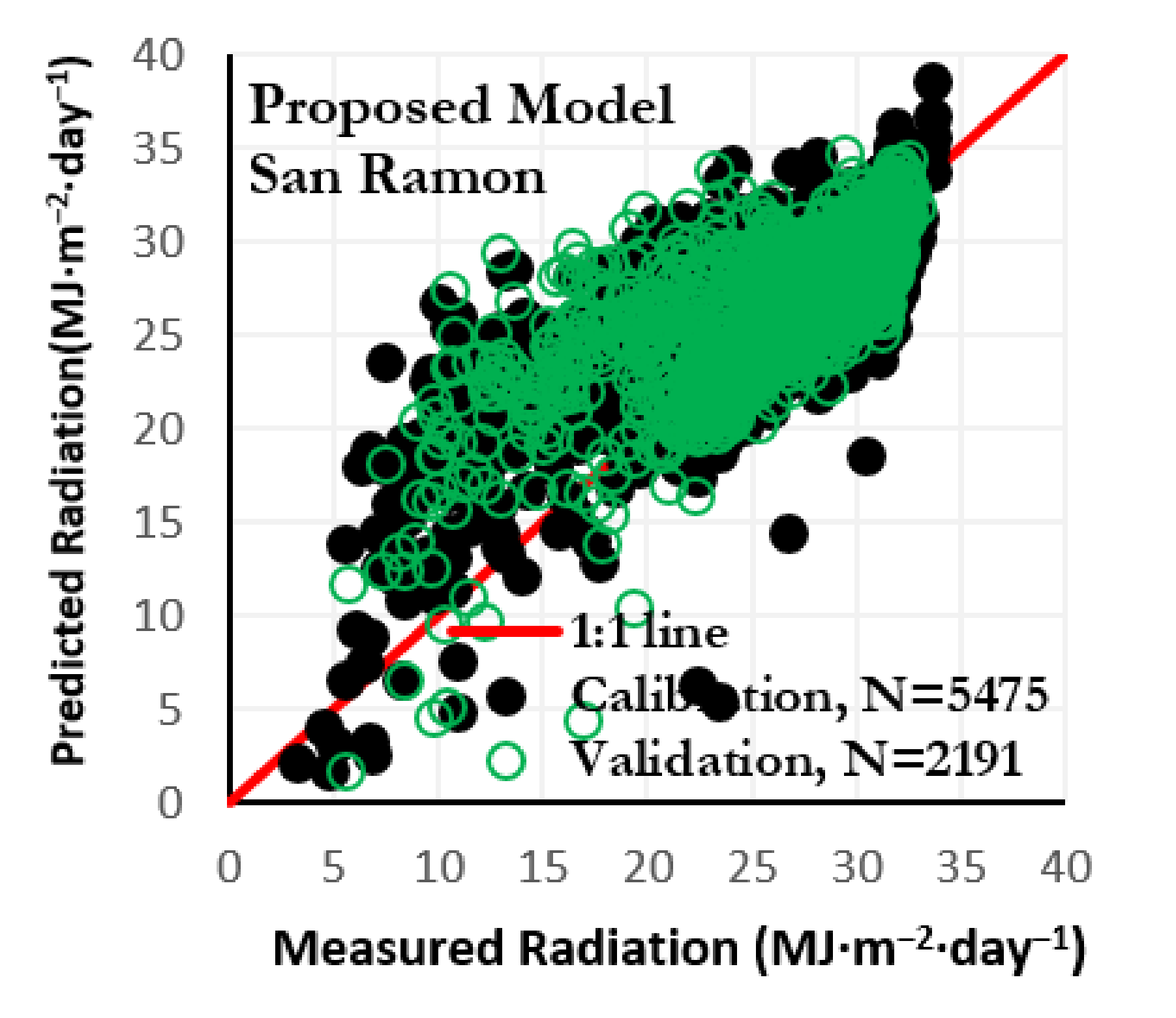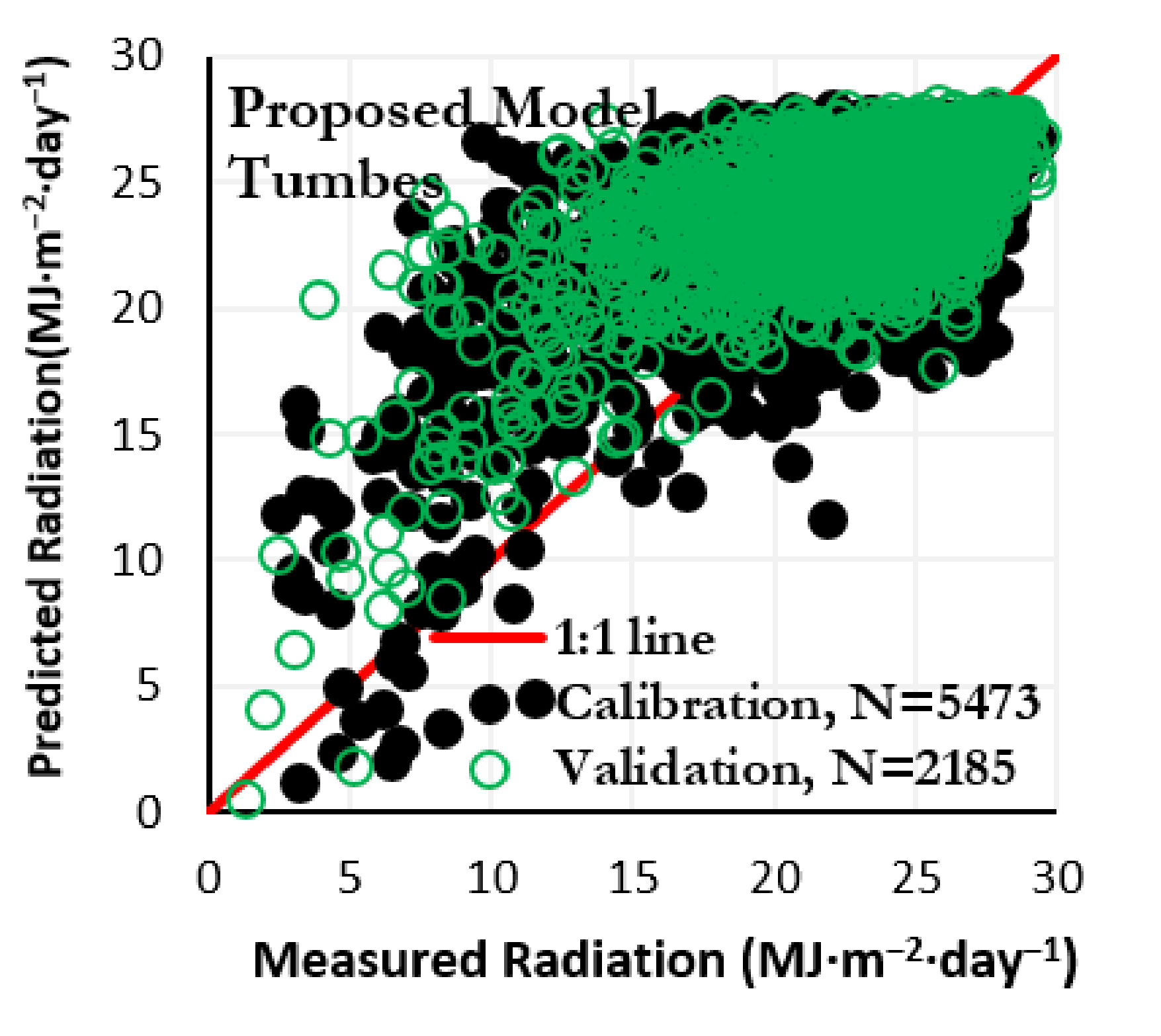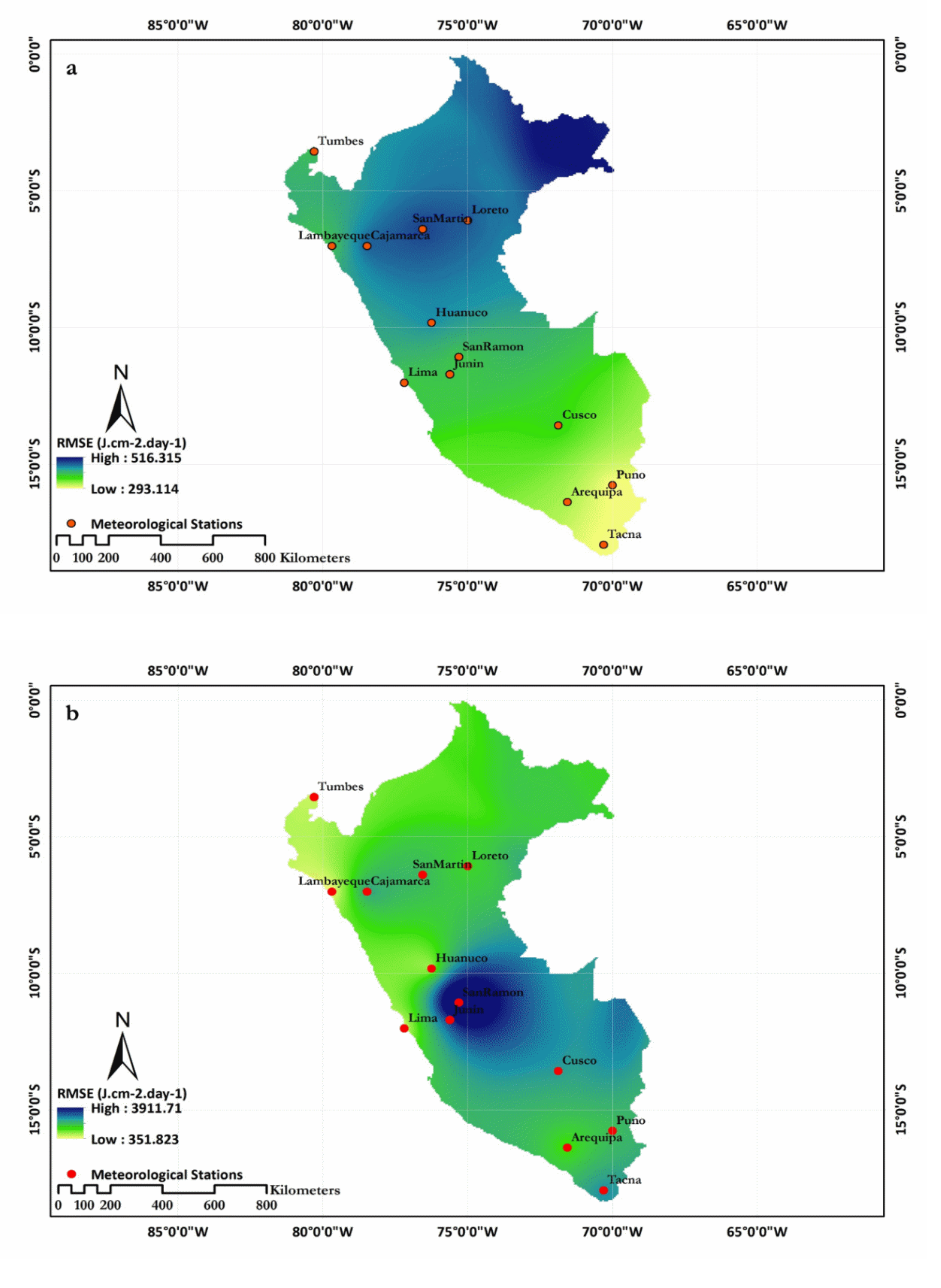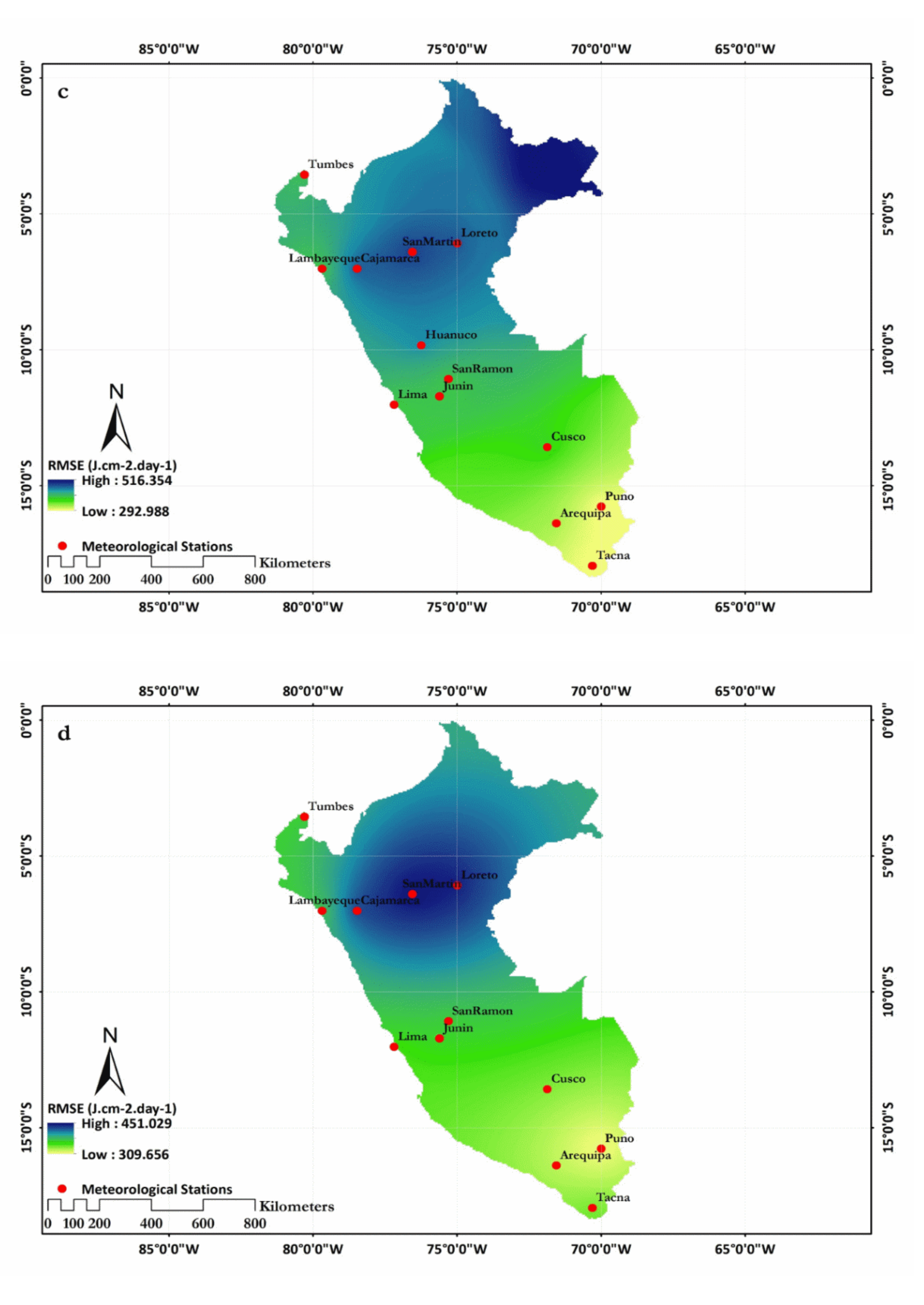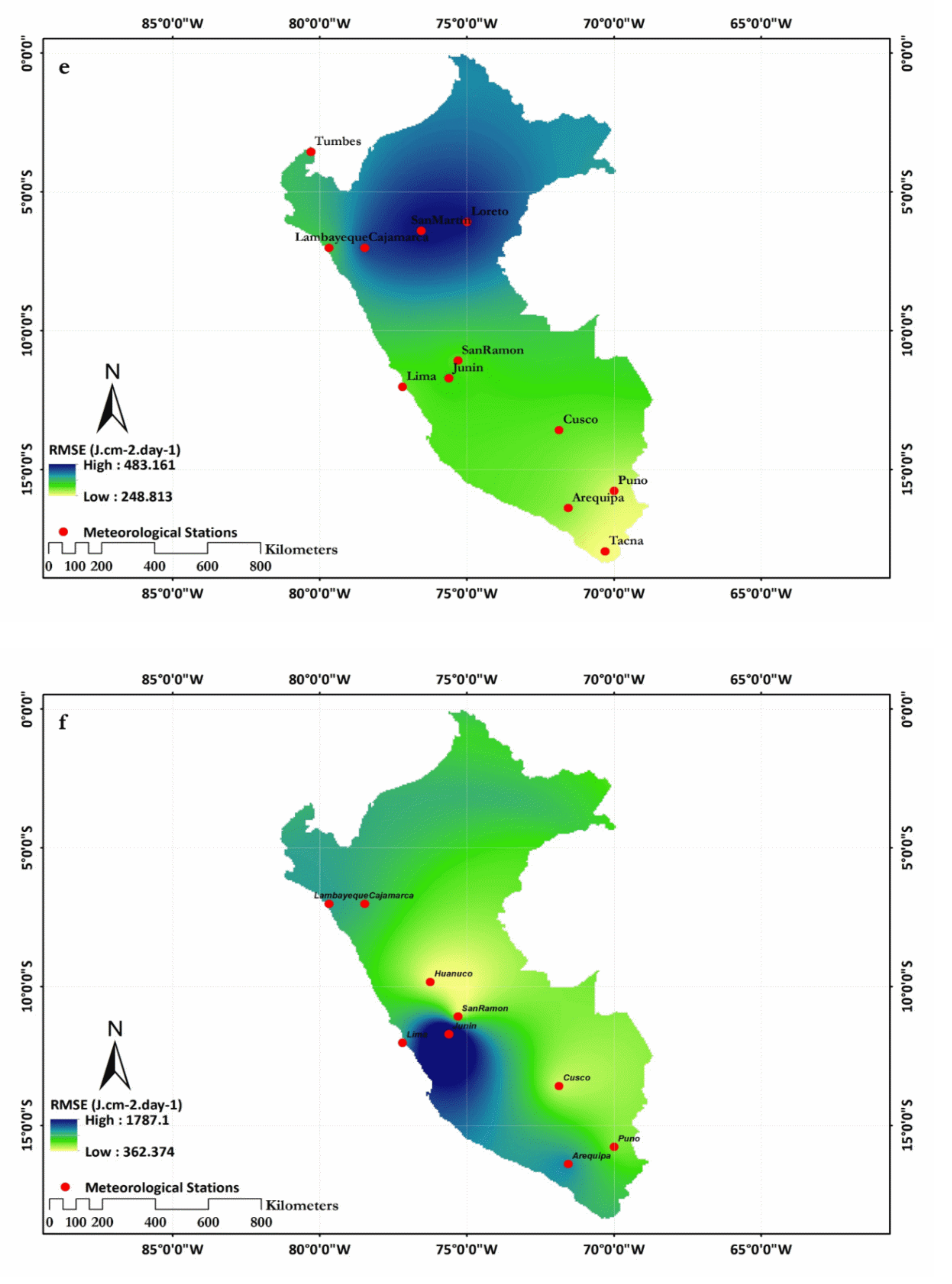Figure 1.
Geographic location of the study area and meteorological stations used in this study.
Figure 1.
Geographic location of the study area and meteorological stations used in this study.
Figure 2.
Measured solar radiation versus values estimated by best and poorest empirical models in calibration and validation sets at all stations.
Figure 2.
Measured solar radiation versus values estimated by best and poorest empirical models in calibration and validation sets at all stations.
Figure 3.
Solar radiation estimated by proposed model at Arequipa station versus measured values in calibration and validation sets.
Figure 3.
Solar radiation estimated by proposed model at Arequipa station versus measured values in calibration and validation sets.
Figure 4.
Solar radiation estimated by proposed model at Cajamarca station versus measured values in calibration and validation sets.
Figure 4.
Solar radiation estimated by proposed model at Cajamarca station versus measured values in calibration and validation sets.
Figure 5.
Solar radiation estimated by proposed model at Cusco station versus measured values in calibration and validation sets.
Figure 5.
Solar radiation estimated by proposed model at Cusco station versus measured values in calibration and validation sets.
Figure 6.
Solar radiation estimated by proposed model at Huanuco station versus measured values in calibration and validation sets.
Figure 6.
Solar radiation estimated by proposed model at Huanuco station versus measured values in calibration and validation sets.
Figure 7.
Solar radiation estimated by proposed model at Junin station versus measured values in calibration and validation sets.
Figure 7.
Solar radiation estimated by proposed model at Junin station versus measured values in calibration and validation sets.
Figure 8.
Solar radiation estimated by proposed model at Lambayeque station versus measured values in calibration and validation sets.
Figure 8.
Solar radiation estimated by proposed model at Lambayeque station versus measured values in calibration and validation sets.
Figure 9.
Solar radiation estimated by proposed model at Lima station versus measured values in calibration and validation sets.
Figure 9.
Solar radiation estimated by proposed model at Lima station versus measured values in calibration and validation sets.
Figure 10.
Solar radiation estimated by proposed model at Loreto station versus measured values in calibration and validation sets.
Figure 10.
Solar radiation estimated by proposed model at Loreto station versus measured values in calibration and validation sets.
Figure 11.
Solar radiation estimated by proposed model at Puno station versus measured values in calibration and validation sets.
Figure 11.
Solar radiation estimated by proposed model at Puno station versus measured values in calibration and validation sets.
Figure 12.
Solar radiation estimated by proposed model at San Martin station versus measured values in calibration and validation sets.
Figure 12.
Solar radiation estimated by proposed model at San Martin station versus measured values in calibration and validation sets.
Figure 13.
Solar radiation estimated by proposed model at San Ramon station versus measured values in calibration and validation sets.
Figure 13.
Solar radiation estimated by proposed model at San Ramon station versus measured values in calibration and validation sets.
Figure 14.
Solar radiation estimated by proposed model at Tacna station versus measured values in calibration and validation sets.
Figure 14.
Solar radiation estimated by proposed model at Tacna station versus measured values in calibration and validation sets.
Figure 15.
Solar radiation estimated by proposed model at Tumbes station versus measured values in calibration and validation sets.
Figure 15.
Solar radiation estimated by proposed model at Tumbes station versus measured values in calibration and validation sets.
Figure 16.
Interpolated spatial distribution of error in solar radiation estimation at all stations using (
a) Hargreaves-Samani [
30] and (
b) Samani [
31] models (
c) Annandale et al. [
32] and (
d) Chen et al. [
33] models (
e) Wu et al. [
36] and (
f) Jahani et al. 1 [
2] models (
g) Jahani et al. 2 [
2] and (
h) proposed models.
Figure 16.
Interpolated spatial distribution of error in solar radiation estimation at all stations using (
a) Hargreaves-Samani [
30] and (
b) Samani [
31] models (
c) Annandale et al. [
32] and (
d) Chen et al. [
33] models (
e) Wu et al. [
36] and (
f) Jahani et al. 1 [
2] models (
g) Jahani et al. 2 [
2] and (
h) proposed models.
Table 1.
Statistical indices for climatic parameters recorded in 13 Peruvian meteorological stations over the time period covered in this study.
Table 1.
Statistical indices for climatic parameters recorded in 13 Peruvian meteorological stations over the time period covered in this study.
| Parameter | CV | SD | Mean | Max | Min |
|---|
| Min temperature (°C) | 0.8 | 8.41 | 10.45 | 28.9 | −17.3 |
| Max temperature (°C) | 0.32 | 7 | 21.96 | 42.7 | 0.9 |
| Altitude (m) | 0.86 | 1749.49 | 2026 | 4990 | 17 |
| Relative humidity (%) | 0.23 | 15.9 | 68.1 | 99 | 4 |
| Extraterrestrial Radiation (MJ·m−2·day−1) | 0.19 | 4.21 | 35.47 | 41.71 | 25.07 |
| Solar Radiation (MJ·m−2·day−1) | 0.3 | 6.77 | 22.25 | 37.44 | 0.65 |
Table 2.
Empirical models used for estimating solar radiation.
Table 2.
Empirical models used for estimating solar radiation.
| Empirical Model | Equation |
|---|
| Hargreaves-Samani [30] | |
| Samani [31] | |
| Annandale et al. [32] | |
| Chen et al. [33] | |
| Wu et al. [36] | |
| Jahani et al. 1 [2] | |
| Jahani et al. 2 [2] | |
Table 3.
Calibrated coefficients for the best empirical models for each station.
Table 3.
Calibrated coefficients for the best empirical models for each station.
| Station | Best Model | Model Coefficients |
|---|
| Tumbes | Jahani et al. 2 (2017) | γ1 = −0.827, γ2 = 0.644, γ3 = −0.017, γ4 = 0.000063 |
| Cusco | Wu et al. (2007) | i1 = −0.456, i2 = 0.289, i3 = 0.024, i4 = −0.059 |
| Arequipa | Wu et al. (2007) | i1 = −0.223, i2 = 0.243, i3 = 0.015, i4 = −0.083 |
| Lima | Wu et al. (2007) | i1 = 0.444, i2 = 0.165, i3 = −0.008, i4 = −0.083 |
| Loretto | Chen et al. (2004) | e1 = 0.022, e2 = 0.194 |
| SanRamon | Wu et al. (2007) | i1 = −0.021, i2 = 0.15, i3 = 0.01, i4 = −0.18 |
| Puno | Wu et al. (2007) | i1 = 0.136, i2 = 0.156, i3 = 0.004, i4 = −0.06 |
| Tacna | Wu et al. (2007) | i1 = 0.221, i2 = 0.131, i3 = 0.004, i4 = −0.075 |
| SanMartin | Chen et al. (2004) | e1 = −0.031, e2 = 0.215 |
| Lambayeque | Chen et al. (2004) | e1 = 0.215, e2 = 0.238 |
| Junin | Wu et al. (2007) | i1 = −0.148, i2 = 0.234, i3 = 0.006, i4 = −0.078 |
| Cajamarca | Wu et al. (2007) | i1 = 0.044, i2 = 0.223, i3 = −0.015, i4 = −0.122 |
| Huanuco | Jahani et al. 1 (2017) | β1 = −0.002, β1 = 0.05, β1 = 0.002, β1 = −0.000093 |
Table 4.
Root mean square errors (RMSEs) (J·cm−2·day−1) of solar radiation estimated by empirical models in selected meteorological stations (calibration set).
Table 4.
Root mean square errors (RMSEs) (J·cm−2·day−1) of solar radiation estimated by empirical models in selected meteorological stations (calibration set).
| Models | Stations |
|---|
| Tumbes | Cusco | Arequipa | Lima | Loretto | SanRamon | Puno | Tacna | SanMartin | Lambayeque | Junin | Cajamarca | Huanuco |
|---|
| Hg-Sa | 313.3 | 400.9 | 385.7 | 299 | 504.9 | 310.1 | 261.5 | 242.2 | 525.6 | 252.5 | 364.1 | 524.6 | 481.3 |
| Sa | 510.2 | 1840.5 | 998.4 | 375.2 | 1464.6 | 3969.5 | 1250.7 | 1975.1 | 1660 | 285.2 | 2029.3 | 1475.9 | 697.2 |
| An | 313.3 | 401.1 | 385.8 | 298.5 | 505 | 310.1 | 261.5 | 241.5 | 525.6 | 252.5 | 364.1 | 524.4 | 481.9 |
| Chen | 302 | 345.3 | 339.7 | 286.1 | 489.7 | 302.1 | 257 | 221.6 | 514.4 | 233.6 | 325.1 | 497 | - |
| Wu | 310.6 | 307.7 | 338.3 | 274 | 501 | 239.7 | 253.7 | 220 | 520.1 | 236.8 | 308.2 | 473.8 | - |
| Ja1 | - | 400.5 | 901.7 | 658.3 | - | 413.2 | 534.8 | - | - | 722.6 | 1553.8 | 691.4 | 371.8 |
| Ja2 | 293 | 980.9 | 1026.4 | 296.3 | 1087 | 1738.8 | 269.5 | 972.1 | 589.1 | 282.9 | 2679 | 1087 | 645.9 |
Table 5.
RMSEs (J·cm−2·day−1) of solar radiation estimated by empirical models in selected meteorological stations (validation set).
Table 5.
RMSEs (J·cm−2·day−1) of solar radiation estimated by empirical models in selected meteorological stations (validation set).
| Models | Stations |
|---|
| Tumbes | Cusco | Arequipa | Lima | Loreto | SanRamon | Puno | Tacna | San Martin | Lambayeque | Junin | Cajamarca | Huanuco |
|---|
| Hg-Sa | 349.1 | 412.1 | 336.7 | 346.6 | 500.6 | 351.1 | 242.4 | 269.6 | 530.6 | 307.6 | 398.8 | 551 | 478.9 |
| Sa | 546.4 | 1760 | 1025.6 | 480.6 | 1181.6 | 3958.4 | 1417.5 | 1845.2 | 1479.6 | 338.6 | 2300.7 | 1666.7 | 727.6 |
| An | 349.2 | 412.6 | 337.5 | 345.1 | 500.5 | 351.9 | 242.2 | 270.7 | 530.3 | 307.6 | 398.9 | 551.2 | 479.7 |
| Chen | 336.6 | 345.3 | 315.6 | 324.9 | 488 | 343.9 | 236.3 | 370.5 | 517.6 | 275 | 378.6 | 531.9 | - |
| Wu | 351.1 | 317.6 | 314.8 | 291.9 | 508 | 272.8 | 246.4 | 227.1 | 517.7 | 281.9 | 364.3 | 505.8 | - |
| Ja1 | - | 422.5 | 919.5 | 794.9 | - | 412.7 | 539.1 | - | - | 850.3 | 1801.8 | 773.5 | 367.1 |
| Ja2 | 337.2 | 924.8 | 1047.9 | 371.5 | 866.9 | 1764 | 262.1 | 900.8 | 616.9 | 315.2 | 3005.7 | 1233.7 | 670.1 |
Table 6.
New models proposed for estimating solar radiation in each station.
Table 6.
New models proposed for estimating solar radiation in each station.
| Station | Proposed Model |
|---|
| Arequipa | |
| Cajamarca | |
| Cusco | |
| Huanuco | |
| Junin | |
| Lambayeque | |
| Lima | |
| Loreto | |
| Puno | |
| San Martin | |
| San Ramon | |
| Tacna | |
| Tumbes | |
Table 7.
RMSEs (J·cm−2·day−1) and number of data points (proposed model) in under- and overestimation sets for measured solar radiation values lower or higher than 20 MJ·m−2·day−1 in validation set.
Table 7.
RMSEs (J·cm−2·day−1) and number of data points (proposed model) in under- and overestimation sets for measured solar radiation values lower or higher than 20 MJ·m−2·day−1 in validation set.
| | Measured Rs Lower than 20 MJ·m−2·day−1 | Measured Rs Higher than 20 MJ·m−2·day−1 |
|---|
| Data Set | Under-Estimated | Overestimated | Underestimated | Overestimated |
|---|
| validation | 284.4 (n = 27) | 559.6 (n = 197) | 236.9 (n = 1085) | 234.5 (n = 881) |
Table 8.
RMSE values (J·cm−2·day−1) and number of data points in under- and overestimation sets for measured solar radiation values lower or higher than mean (Rs)mea in calibration and validation sets.
Table 8.
RMSE values (J·cm−2·day−1) and number of data points in under- and overestimation sets for measured solar radiation values lower or higher than mean (Rs)mea in calibration and validation sets.
| | Measured Rs Lower than Mean (Rs)mea | Measured Rs Higher than Mean (Rs)mea |
|---|
| Data Set | Underestimated | Overestimated | Underestimated | Overestimated |
|---|
| calibration | 189.9 (n = 675) | 405.5 (n = 2116) | 371.9 (n = 2012) | 453.3 (n = 676) |
| validation | 188.2 (n = 200) | 487.6 (n = 946) | 384.3 (n = 747) | 598.8 (n = 297) |
Table 9.
RMSE values (J·cm−2·day−1) and number of data points belonging to under- and overestimation sets in calibration and validation phases using proposed model.
Table 9.
RMSE values (J·cm−2·day−1) and number of data points belonging to under- and overestimation sets in calibration and validation phases using proposed model.
| Data Set | Calibration | Validation |
|---|
| underestimated | 242.5 (n = 3061) | 244 (n = 1170) |
| overestimated | 324 (n = 2412) | 339.5 (n = 1021) |
Table 10.
RMSE values (J·cm−2·day−1) and number of data points belonging to each group separated by a threshold value (mean of measured solar radiation): lower and higher than the mentioned threshold in calibration and validation sets.
Table 10.
RMSE values (J·cm−2·day−1) and number of data points belonging to each group separated by a threshold value (mean of measured solar radiation): lower and higher than the mentioned threshold in calibration and validation sets.
| Data Set | Calibration | Validation |
|---|
| Rs < Mean (Rs)mea | 326 (n = 2224) | 345.4 (n = 867) |
| Rs > Mean (Rs)mea | 246.1 (n = 3249) | 251.7 (n = 1324) |
Table 11.
RMSE values (J·cm−2·day−1) and number of data points belonging to under- and overestimation sets for measured solar radiation less or higher than mean (Rs)mea in calibration and validation phases using proposed model.
Table 11.
RMSE values (J·cm−2·day−1) and number of data points belonging to under- and overestimation sets for measured solar radiation less or higher than mean (Rs)mea in calibration and validation phases using proposed model.
| | Measured Rs Lower than Mean (Rs)mea | Measured Rs Higher than Mean (Rs)mea |
|---|
| Data Set | Underestimated | Overestimated | Underestimated | Overestimated |
|---|
| calibration | 176.9 (n = 865) | 353.8 (n = 1970) | 357.3 (n = 1716) | 327.5 (n = 902) |
| validation | 174.3 (n = 248) | 400 (n = 842) | 333.3 (n = 644) | 439.6 (n = 457) |
Table 12.
RMSE values (J·cm−2·day−1) and number of data points belonging to under- and overestimation sets for measured solar radiation less or higher than mean (Rs)mea in calibration and validation phases using proposed model.
Table 12.
RMSE values (J·cm−2·day−1) and number of data points belonging to under- and overestimation sets for measured solar radiation less or higher than mean (Rs)mea in calibration and validation phases using proposed model.
| | Measured Rs Lower than Mean (Rs)mea | Measured Rs Higher than Mean (Rs)mea |
|---|
| Data Set | Underestimated | Overestimated | Total Data Set | Underestimated | Overestimated | Total Data Set |
|---|
| calibration | 239.6 | 444.2 | 370.8 | 240.2 | 194.5 | 227.5 |
| (n = 1112) | (n = 1489) | (n = 2601) | (n = 2010) | (n = 860) | (n = 2870) |
| validation | 225.8 | 524.7 | 457 | 219.9 | 243.4 | 229.3 |
| (n = 292) | (n = 694) | (n = 986) | (n = 736) | (n = 469) | (n = 1205) |
Table 13.
RMSE values (J·cm−2·day−1) and number of data points belonging to under- and overestimation sets in three defined intervals of measured solar radiation (MJ·m−2·day−1) for calibration and validation phases using proposed model.
Table 13.
RMSE values (J·cm−2·day−1) and number of data points belonging to under- and overestimation sets in three defined intervals of measured solar radiation (MJ·m−2·day−1) for calibration and validation phases using proposed model.
| | Calibration | Validation |
|---|
| Data Set | Rs < 10 | 10 ≤ Rs < 20 | Rs ≥ 20 | Rs < 10 | 10 ≤ Rs < 20 | Rs ≥ 20 |
|---|
| underpredicted | 379 (n = 2) | 139.2 (n = 221) | 144.8 (n = 3180) | 184 (n = 1) | 60.62 (n = 29) | 113.3 (n = 1109) |
| overpredicted | 750.8 (n = 35) | 462.7 (n = 565) | 181.1 (n = 1474) | 1088.5 (n = 16) | 559 (n = 264) | 200.3 (n = 772) |
Table 14.
RMSE values (J·cm−2·day−1) and number of data points belonging to under- and overestimation sets in three defined intervals of measured solar radiation (MJ·m−2·day−1) for calibration and validation phases using proposed model.
Table 14.
RMSE values (J·cm−2·day−1) and number of data points belonging to under- and overestimation sets in three defined intervals of measured solar radiation (MJ·m−2·day−1) for calibration and validation phases using proposed model.
| | Calibration | Validation |
|---|
| Data Set | Rs < 15 | 15 ≤ Rs < 25 | Rs ≥ 25 | Rs < 15 | 15 ≤ Rs < 25 | Rs ≥ 25 |
|---|
| underestimated | 534.4 (n = 17) | 151.1 (n = 1618) | 159.7 (n = 1859) | - | 101.9 (n = 586) | 95.7 (n = 663) |
| (n = 0) |
| overestimated | 677.6 (n = 141) | 371.9 (n = 1163) | 140 (n = 679) | 1047.2 (n = 28) | 469.7 (n = 565) | 180.6 (n = 349) |
Table 15.
RMSE values (J·cm−2·day−1) and number of data points belonging to under- and overestimation sets in three defined intervals of measured solar radiation (MJ·m−2·day−1) for calibration and validation phases using proposed model.
Table 15.
RMSE values (J·cm−2·day−1) and number of data points belonging to under- and overestimation sets in three defined intervals of measured solar radiation (MJ·m−2·day−1) for calibration and validation phases using proposed model.
| | Calibration | Validation |
|---|
| Data Set | Rs < 10 | 10 ≤ Rs < 20 | Rs ≥ 20 | Rs < 10 | 10 ≤ Rs < 20 | Rs ≥ 20 |
|---|
| underestimated | 143.5 (n = 34) | 290.7 (n = 1024) | 548.3 (n = 1670) | 207.6 (n = 3) | 266.2 (n = 342) | 501.9 |
| (n = 699) |
| overestimated | 673.3 (n = 691) | 426.8 (n = 1989) | 103 (n = 64) | 698.9 (n = 295) | 416.9 (n = 797) | 140.4 (n = 51) |
Table 16.
RMSE values (J·cm−2·day−1) and number of data points belonging to under- and overestimation sets for measured solar radiation less or higher than mean (Rs)mea in calibration and validation phases using proposed model.
Table 16.
RMSE values (J·cm−2·day−1) and number of data points belonging to under- and overestimation sets for measured solar radiation less or higher than mean (Rs)mea in calibration and validation phases using proposed model.
| | Measured Rs Lower than Mean (Rs)mea | Measured Rs Higher than Mean (Rs)mea |
|---|
| Data Set | Underpredicted | Overpredicted | Underpredicted | Overpredicted |
|---|
| calibration | 145.6 (n = 1308) | 321.4 (n = 1577) | 252.7 (n = 1834) | 181.5 (n = 760) |
| validation | 119.9 (n = 452) | 321.8 (n = 689) | 208.4 (n = 585) | 192.2 (n = 465) |
Table 17.
RMSE values (J·cm−2·day−1) and number of data points belonging to under- and overestimation sets in three defined intervals of measured solar radiation (MJ·m−2·day−1) for calibration and validation phases using proposed model.
Table 17.
RMSE values (J·cm−2·day−1) and number of data points belonging to under- and overestimation sets in three defined intervals of measured solar radiation (MJ·m−2·day−1) for calibration and validation phases using proposed model.
| | Calibration | Validation |
|---|
| Data Set | Rs < 15 | 15 ≤ Rs < 30 | Rs ≥ 30 | Rs < 15 | 15 ≤ Rs < 30 | Rs ≥ 30 |
|---|
| underpredicted | - | 175.9 (n = 1981) | 268.2 (n = 1166) | 181.8 | 140 (n = 682) | 228.7 (n = 354) |
| (n = 0) | (n = 1) |
| overpredicted | 601.8 (n = 49) | 288 (n = 1990) | 131.2 (n = 298) | 642.4 (n = 16) | 285 (n = 958) | 151 |
| (n = 180) |
Table 18.
RMSE values (J·cm−2·day−1) and number of data points belonging to under- and overestimation sets for measured solar radiation less or higher than mean (Rs)mea in calibration and validation phases using proposed model.
Table 18.
RMSE values (J·cm−2·day−1) and number of data points belonging to under- and overestimation sets for measured solar radiation less or higher than mean (Rs)mea in calibration and validation phases using proposed model.
| | Measured Rs Lower than Mean (Rs)mea | Measured Rs Higher than Mean (Rs)mea |
|---|
| Data Set | Underestimated | Overestimated | Underestimated | Overestimated |
|---|
| calibration | 214.3 (n = 318) | 524.7 (n = 2312) | 563.9 (n = 2220) | 221.7 (n = 616) |
| validation | 196.9 (n = 118) | 529 (n = 938) | 551.4 (n = 953) | 221 (n = 175) |
Table 19.
RMSE values (J·cm−2·day−1) and number of data points belonging to under- and overestimation sets in three defined intervals of measured solar radiation (MJ·m−2·day−1) for calibration and validation phases using proposed model.
Table 19.
RMSE values (J·cm−2·day−1) and number of data points belonging to under- and overestimation sets in three defined intervals of measured solar radiation (MJ·m−2·day−1) for calibration and validation phases using proposed model.
| | Calibration | Validation |
|---|
| Data Set | Rs < 10 | 10 ≤ Rs < 20 | Rs ≥ 20 | Rs < 10 | 10 ≤ Rs < 20 | Rs ≥ 20 |
|---|
| underestimated | 169.7 | 310.5 (n = 919) | 633 (n = 1574) | 135.8 | 279.8 (n = 370) | 620.3 (n = 689) |
| (n = 45) | (n = 12) |
| overestimated | 632 (n = 741) | 417.3 (n = 2126) | 102.7 (n = 61) | 645.4 (n = 345) | 411.9 (n = 749) | 107.2 |
| (n = 19) |
Table 20.
RMSE values (J·cm−2·day−1) and number of data points belonging to under- and overestimation sets in two defined intervals of measured solar radiation (MJ·m−2·day−1) for calibration and validation phases using proposed model.
Table 20.
RMSE values (J·cm−2·day−1) and number of data points belonging to under- and overestimation sets in two defined intervals of measured solar radiation (MJ·m−2·day−1) for calibration and validation phases using proposed model.
| | Calibration | Validation |
|---|
| Data Set | Rs < 20 | Rs ≥ 20 | Rs < 20 | Rs ≥ 20 |
|---|
| underestimated | 263.3 (n = 20) | 180.5 (n = 3513) | 469.1 (n = 15) | 167.5 (n = 1410) |
| overestimated | 737.5 (n = 277) | 207.5 (n = 1665) | 836.6 (n = 142) | 241.7 (n = 624) |
Table 21.
RMSE values (J·cm−2·day−1) and number of data points belonging to under- and overestimation sets in three defined intervals of measured solar radiation (MJ·m−2·day−1) for calibration and validation phases using proposed model.
Table 21.
RMSE values (J·cm−2·day−1) and number of data points belonging to under- and overestimation sets in three defined intervals of measured solar radiation (MJ·m−2·day−1) for calibration and validation phases using proposed model.
| | Calibration | Validation |
|---|
| Data Set | Rs < 15 | 15 ≤ Rs < 25 | Rs ≥ 25 | Rs < 15 | 15 ≤ Rs < 25 | Rs ≥ 25 |
|---|
| underestimated | 552.2 | 101.4 (n = 1453) | 188.2 (n = 1854) | 715.7 | 134.9 (n = 725) | 236.9 (n = 932) |
| (n = 3) | (n = 4) |
| overestimated | 583.2 (n = 60) | 294 (n = 1111) | 166.6 (n = 998) | 706.5 (n = 18) | 318.4 (n = 251) | 165.3 |
| (n = 261) |
Table 22.
RMSE values (J·cm−2·day−1) and number of data points belonging to under- and overestimation sets in two defined intervals of measured solar radiation (MJ·m−2·day−1) for calibration and validation phases using proposed model.
Table 22.
RMSE values (J·cm−2·day−1) and number of data points belonging to under- and overestimation sets in two defined intervals of measured solar radiation (MJ·m−2·day−1) for calibration and validation phases using proposed model.
| | Calibration | Validation |
|---|
| Data Set | Rs < 20 | Rs ≥ 20 | Rs < 20 | Rs ≥ 20 |
|---|
| underestimated | 239.4 (n = 38) | 200.1 (n = 3442) | 146 (n = 8) | 167.2 (n = 1067) |
| overestimated | 649.2 (n = 608) | 198.7 (n = 1385) | 703.4 (n = 337) | 222.1 (n = 773) |
Table 23.
RMSEs (J·cm−2·day−1) of the proposed models and percentage of RMSE reduction by proposed models compared to best, poorest, and average results of empirical models in each of the 13 selected stations at calibration (validation) set.
Table 23.
RMSEs (J·cm−2·day−1) of the proposed models and percentage of RMSE reduction by proposed models compared to best, poorest, and average results of empirical models in each of the 13 selected stations at calibration (validation) set.
| Percentage of RMSE Reduction Compared to the Average of All Empirical Models | Percentage of RMSE Reduction Compared to the Poorest-Performing Empirical Model | Percentage of RMSE Reduction Compared to the Best Empirical Model | RMSE (J·cm−2·day−1) | Station |
|---|
| 53 (54.2) | 71.4 (73.2) | 13.2 (10.7) | 293.7 (281.2) | Arequipa |
| 49.6 (45.5) | 74.3 (72.8) | 19.9 (10.5) | 379.6 (452.7) | Cajamarca |
| 57.9 (55.5) | 84.7 (83.4) | 8.6 (7.9) | 281.3 (292.4) | Cusco |
| 38.6 (31.8) | 52.8 (44.6) | 11.6 (1.1) | 328.8 (371.3) | Huanuco |
| 72 (71.6) | 88.6 (88.3) | 1.3 (3.8) | 304.2 (350.6) | Junin |
| 32.6 (32.3) | 69.8 (69.6) | 6.7 (5.9) | 218 (258.8) | Lambayeque |
| 31.1 (32.2) | 62.8 (64) | 10.7 (2.1) | 244.7 (285.8) | Lima |
| 36.6 (30.2) | 67.2 (60.2) | 1.8 (3.6) | 480.9 (470.5) | Loreto |
| 44.1 (48.5) | 80.3 (83.5) | 2.8 (0.8) | 246.5 (234.4) | Puno |
| 30.3 (27.2) | 69.7 (65.6) | 2 (1.7) | 503.8 (508.8) | San Martin |
| 76.1 (73.2) | 93.7 (92.8) | 3.7 (4.7) | 248.5 (285.6) | San Ramon |
| 68.6 (65.5) | 89.7 (87.9) | 7.8 (1.7) | 202.9 (223.2) | Tacna |
| 15.7 (13.3) | 43.7 (40) | 2 (2.6) | 287 (327.8) | Tumbes |
